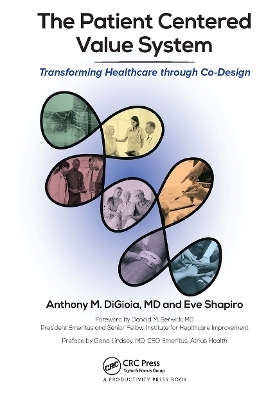
The Patient Centered Value System
CRC Press (Verlag)
978-0-367-73583-8 (ISBN)
Imagine: You are a hospital Chief Executive Officer, Chief Financial Officer, medical or nursing director, patient safety specialist, quality improvement professional, or a doctor or nurse on the front lines of patient care. Every day you’re aware that patients and families should be more engaged in their care so they would fare better both in the hospital and after discharge; their care could be safer and more seamlessly coordinated; patients should be ready for discharge sooner and readmitted less often; your bottom line stronger; your staff more fulfilled. You enter into new payment models such as bundling with an uneasy awareness that your organization is at risk because you don’t know what the care you deliver actually costs.
Like most healthcare leaders, you are also still searching for a way to deliver care that will help you to achieve the Triple Aim: care that leads to improved clinical outcomes, better patient and family care experiences, and reduced costs.
Sound familiar? If so, then it’s time to read The Patient Centered Value System: Transforming Healthcare through Co-Design. This book explains how to introduce the Patient Centered Value System in your organization to go from the current state to the ideal.
The Patient Centered Value System is a three-part approach to co-designing improvements in healthcare delivery—collaborating with patients, families, and frontline providers to design the ideal state of care after listening to their wants and needs. Central to the Patient Centered Value System is seeing every care experience through the eyes of patients and families.
The Patient Centered Value System is a process and performance improvement technique that consists of 1) Shadowing, 2) the Patient and Family Centered Care Methodology, and 3) Time-Driven Activity-Based Costing. Shadowing is the essential tool in the Patient Centered Value System that helps you to see every care experience from the point of view of patients and families and enables you to calculate the true costs of healthcare over the full cycle of care.
Fundamental to the Patient Centered Value System is the building of teams to take you from the currents state of care delivery to the ideal. Healthcare transformation depends not on individual providers working to fix broken systems, but on teams of providers working together while breaking down silos.
The results of using the Patient Centered Value System are patients and families who are actively engaged in their care, which also improves their outcomes; providers who see the care experience from the patient’s and family’s point of view and co-design care delivery as a result; the tight integration of clinical and financial performance; and the realization of the Triple Aim.
Anthony M. DiGioia, III, MD, creator of the Patient Centered Value System, is a practicing orthopeadic surgeon and medical director of both the Bone and Joint Center and Innovation Center at the University of Pittsburgh Medical Center (UPMC). Tony graduated from Carnegie Mellon University in Civil Engineering, obtained a graduate degree in Civil and Biomedical Engineering, and then attended Harvard Medical School, completed his orthopaedic residency in Pittsburgh, and a Fellowship at Massachusetts General Hospital. Wanting to help bridge the gap between engineering and medicine, Tony was a world leader in the initial development of medical robotics and computer assisted surgery. His work has always focused on bringing together diverse teams from multiple disciplines in order to listen to and meet the needs of patients and families. This broad focus led Tony to develop the Patient Centered Value System, which combines process and performance improvement with supportive technologies to improve clinical outcomes and patient and family care experiences while reducing costs. Eve Shapiro, principal, Eve Shapiro Medical Writing, Inc., has written on topics related to patient safety, patient-centered care, systems improvement, transitions in care, physician-patient communication, medical errors, and other subjects for audiences ranging from researchers and clinicians to patients and families. She has written books, articles, and other works for organizations such as the Agency for Healthcare Research and Quality, the Institute for Healthcare Improvement, The Joint Commission, the Robert Wood Johnson Foundation, the University of Pittsburgh Medical Center, and Consumers Advancing Patient Safety. Eve believes storytelling is the most powerful way to teach, generate insight, promote understanding, and communicate essential truths.
Introduction: The Patient Centered Value System: Toward a New Age in Healthcare; Part 1: The Patient Centered Value System in Action: A Story; Chapter 1: How to introduce the Patient Centered Value System in any organization; Chapter 2: Choose your champions: Establish the care experience guiding council; Chapter 3: Shadow patients and families to co-design the care experience; Chapter 4: Develop your care experience working group; Chapter 5: Create a shared vision by writing the story of the ideal care experience; Chapter 6: Close the gaps between the current state and the ideal; Part 2: The Patient Centered Value System in Fact and in Practice; Chapter 7: The Patient Centered Value System: Fact, not fiction; Chapter 8: The true cost methodology of the Patient Centered Value System: A User’s Manual; Chapter 9: The Science behind the Patient Centered Value System: Built on the shoulders of giants.; Chapter 10: Patient Centered Value System + Lean or other process improvement approaches = Rapid Improvement; Chapter 11: The Patient Centered Value System in Practice; Chapter 12: Conclusion; Appendix 1: Glossary; Appendix 2: The Appendix explains what’s needed to assure success of the PCVS, why projects sometimes fail, how to get back on track, and the 65+ care experiences within UPMC that have been improved by use of the PCVS.
| Erscheinungsdatum | 16.01.2021 |
|---|---|
| Verlagsort | London |
| Sprache | englisch |
| Maße | 156 x 234 mm |
| Gewicht | 589 g |
| Themenwelt | Medizin / Pharmazie ► Gesundheitswesen |
| Wirtschaft | |
| ISBN-10 | 0-367-73583-0 / 0367735830 |
| ISBN-13 | 978-0-367-73583-8 / 9780367735838 |
| Zustand | Neuware |
| Haben Sie eine Frage zum Produkt? |
aus dem Bereich


